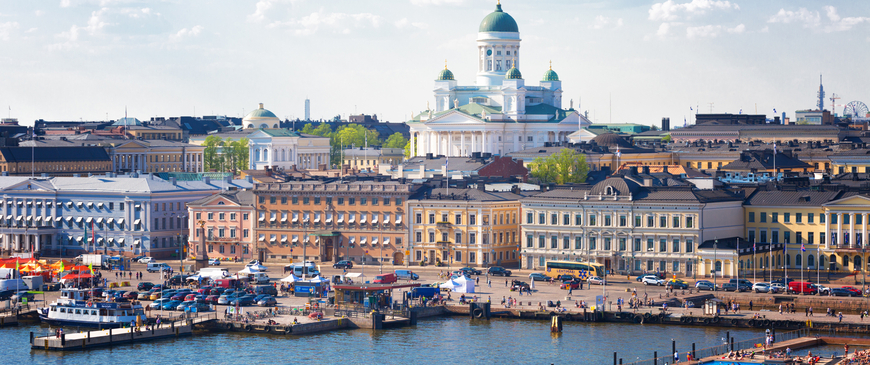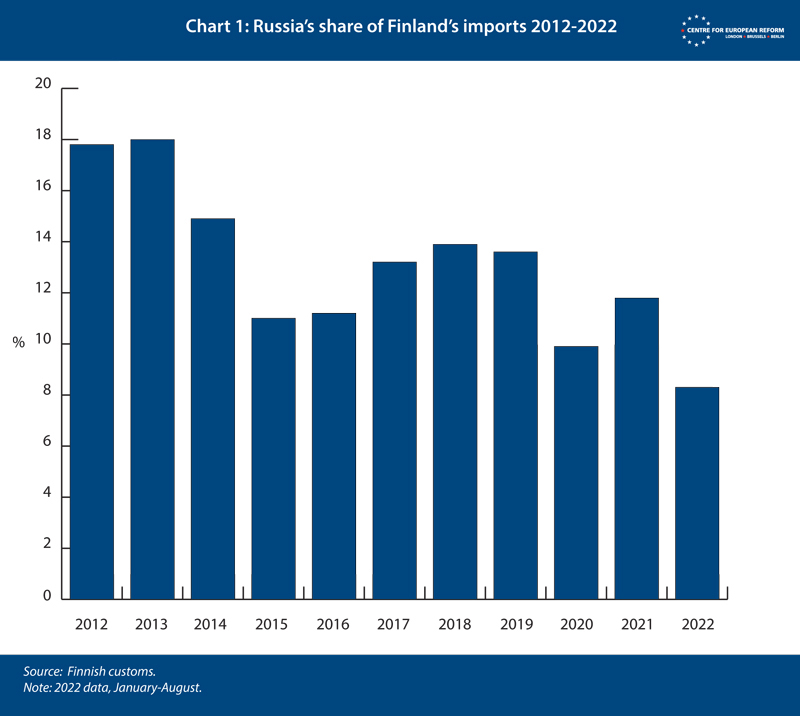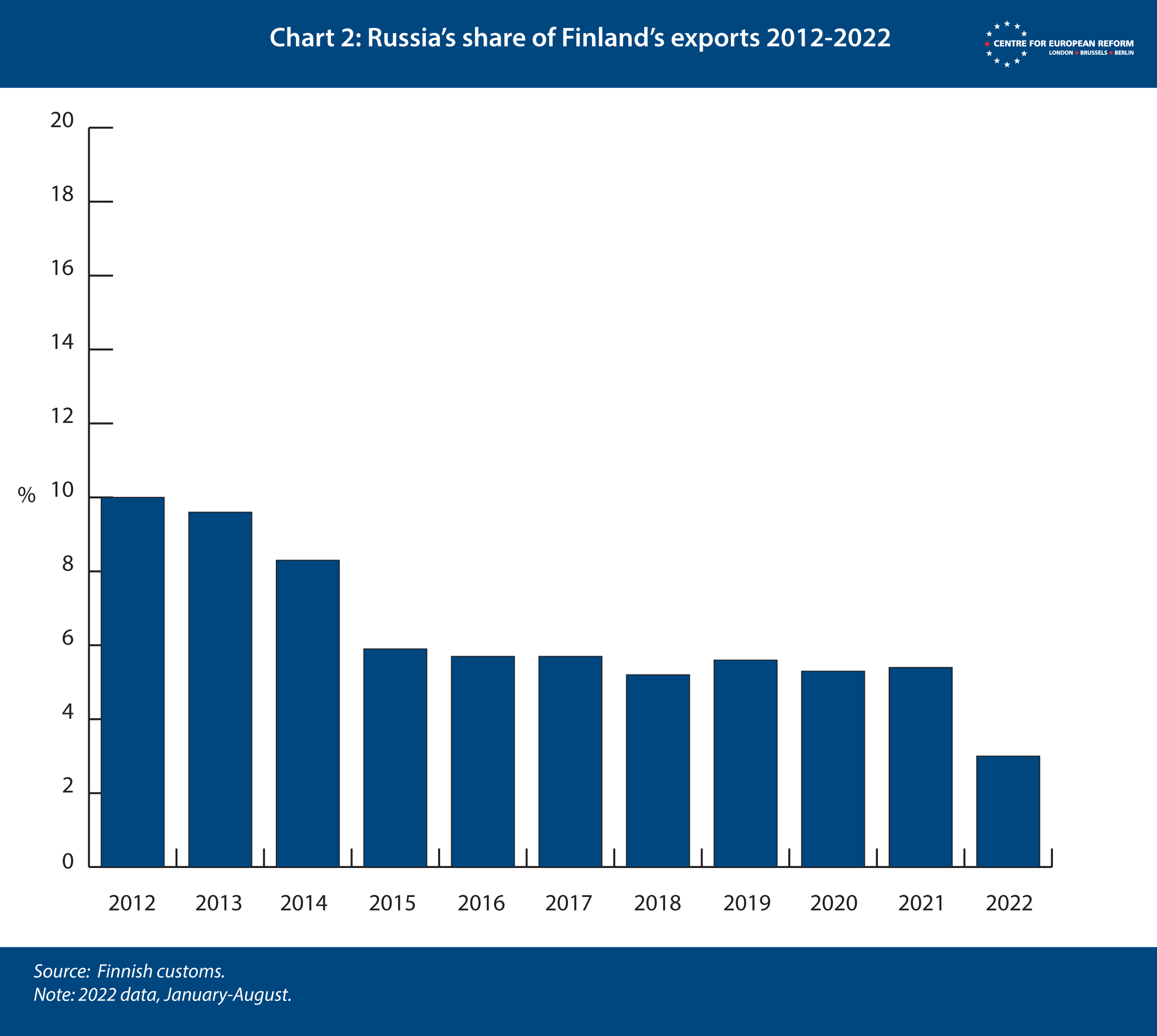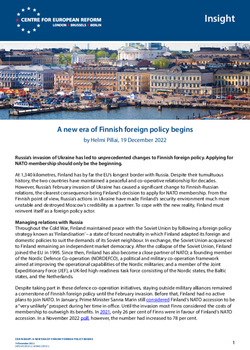
A new era of Finnish foreign policy begins
Russia’s invasion of Ukraine has led to unprecedented changes to Finnish foreign policy. Applying for NATO membership should only be the beginning.
At 1,340 kilometres, Finland has by far the EU’s longest border with Russia. Despite their tumultuous history, the two countries have maintained a peaceful and co-operative relationship for decades. However, Russia’s February invasion of Ukraine has caused a significant change to Finnish-Russian relations, the clearest consequence being Finland’s decision to apply for NATO membership. From the Finnish point of view, Russia’s actions in Ukraine have made Finland’s security environment much more unstable and destroyed Moscow’s credibility as a partner. To cope with the new reality, Finland must re-invent itself as a foreign policy actor.
Managing relations with Russia
Throughout the Cold War, Finland maintained peace with the Soviet Union by following a foreign policy strategy known as ‘Finlandisation’ – a state of forced neutrality in which Finland adapted its foreign and domestic policies to suit the demands of its Soviet neighbour. In exchange, the Soviet Union acquiesced to Finland remaining an independent market democracy. After the collapse of the Soviet Union, Finland joined the EU in 1995. Since then, Finland has also become a close partner of NATO; a founding member of the Nordic Defence Co-operation (NORDEFCO), a political and military co-operation framework aimed at improving the operational capabilities of the Nordic militaries; and a member of the Joint Expeditionary Force (JEF), a UK-led high-readiness task force consisting of the Nordic states, the Baltic states, and the Netherlands.
Despite taking part in these defence co-operation initiatives, staying outside military alliances remained a cornerstone of Finnish foreign policy until the February invasion. Before that, Finland had no active plans to join NATO. In January, Prime Minister Sanna Marin still considered Finland’s NATO accession to be a “very unlikely” prospect during her time in office. Until the invasion most Finns considered the costs of membership to outweigh its benefits. In 2021, only 26 per cent of Finns were in favour of Finland’s NATO accession. In a November 2022 poll, however, the number had increased to 78 per cent.
Until the invasion, most Finns considered the costs of NATO membership to outweigh its benefits.
There were two main reasons for opposing membership. The first was the fear that it could provoke Russia to respond politically or even militarily, and the second was the impact that bad relations would have on Finnish-Russian trade. Until 2013, Russia was Finland’s largest trading partner, a huge outlet for Finnish exports and its primary source of energy imports. Before the February invasion, between 60 to 65 per cent of Finnish energy imports came from Russia. Finland was particularly dependent on Russian imports of natural gas, crude oil and wood fuels. However, as can be seen from the charts below, Russia’s importance as a trade partner for Finland decreased after the annexation of Crimea in 2014 and has further declined in 2022.

Even during the years of closer relations, Finland always viewed Russia as a threat to its sovereignty. To ensure its security, Helsinki has maintained conscription and kept a high level of defence spending. Since 2016, Finnish security white papers have warned that Russia seeks to recreate a sphere of influence in its neighbourhood, which would inevitably be in conflict with Finland’s independence. After Russia’s annexation of Crimea and intervention in eastern Ukraine in 2014, Finland strongly condemned Russia’s actions and supported the EU’s sanctions against it, despite being one of the countries most negatively affected by them. The Finnish authorities also began to pay more attention to suspicious Russian activity in Finland, such as Russian citizens’ real estate purchases near strategically important locations like ports and military bases. In 2019, legislation was passed to make such activity more difficult.
Even during the years of closer relations, Finland always viewed Russia as a threat to its sovereignty.

The mistakes of past Russia-policy
Still, there are many examples of Finland failing to take the Russian threat as seriously as it should have. One was the Finnish Parliament’s debate on approval of the Nord Stream 2 pipeline, which passes through Finland’s exclusive economic zone. When MP Elina Valtonen submitted a written question to the government asking why Finland, unlike many other states, did not factor the pipeline’s geopolitical effects into its analysis, then-prime minister Juha Sipilä argued that security concerns were not relevant to the debate, and the project should, instead, be assessed on its economic and environmental impact. This was the government’s stance despite warnings that the Nord Stream pipelines could give Russia an excuse to increase its naval presence in the Baltic Sea and provide new opportunities for intelligence gathering.
Another way Finland underestimated the Russian threat was in pursuing the Hanhikivi 1 nuclear power plant project, in which the Russian state-owned nuclear company, Rosatom, acquired a 34 per cent share in 2012. Despite broad popular opposition, the Finnish Parliament subsequently approved the project, only months after Russia’s annexation of Crimea. Ville Niinistö – then the leader of the Greens party – criticised the decision, arguing that the government approved the plant solely to appease Russia. In an interview, Niinistö argued: “There is a sense of ‘Finlandisation’ here. We are giving the Russians the very leverage they are looking for with the West and the EU. This puts us into a very vulnerable position”. The project was not cancelled until May 2022, despite repeated warnings of the risk it posed to Finnish security.
The war in Ukraine has caused many to question how certain Finnish politicians could have misjudged the Russian threat. In a recent interview, Mika Aaltola – director of the Finnish Institute of International Affairs – revealed that, until the invasion, high-ranking politicians in Finland pressured researchers to downplay their warnings about Russia, claiming that public discussion on the security threats facing Finland could make the country less attractive to foreign investors.
An unprecedented change
The February invasion, however, "changed everything" for Finnish security, in the words of Marin; this explains why the Finnish Parliament voted overwhelmingly to join NATO in May. Russia’s actions in Ukraine not only demonstrated the value of NATO membership more clearly than ever before, but the invasion also provided a unique opportunity for Helsinki to take this historic step with Russian troops busy in Ukraine and trade already largely paused due to the sanctions.
Still, Helsinki remains concerned about Russian retaliation. Finnish authorities have announced that they are preparing for “exceptional, extensive and multifaceted hybrid influence activities both in the short- and long-term.” This could mean, for example, an attack on critical infrastructure like water or heating systems; sabotaging Finland’s trade routes in the Baltic Sea; or pushing asylum seekers across the Finnish border, as Belarus did on the Polish border last year. But from the Finnish perspective, these risks are worth taking to gain the long-term protection offered by NATO membership.
While the decision to apply for NATO membership has been the most prominent shift in Finnish foreign policy, it has not been the only one. Since February, Finland has taken several steps that would have been difficult to imagine before the invasion. The Finnish leadership has supplied weapons to Ukraine; harshly criticised Russia; banned Russian citizens from entering Finland on tourist visas; and made plans to erect a fence on parts of its eastern border. There has also been something of a national reckoning of Finland’s mistakes in relation to its neighbour. The media has heavily condemned the naivety and opportunism of certain politicians who were unable or unwilling to acknowledge that Russia’s increasingly aggressive foreign policy should affect their decision-making.
A new era of Finnish foreign policy
These are all promising signs of change but for Finland to fully reinvent itself as a foreign policy actor, more action is needed. On the domestic level, Finland should invest more in Russian-language news sources. Although some already exist, these are not reaching Finland’s nearly 90,000 Russian native speakers as effectively as they should. According to a recent study, only 41 per cent of Russian speakers in Finland trust Finnish media. This is clearly reflected in the political views of this minority. Eighteen per cent of Russian-speakers consider the invasion of Ukraine to be justified and an additional 19 per cent do not express any opinion on the subject. While the clear majority of Russian-speakers condemn the invasion, this is still a much lower number compared with the Finnish population as a whole, only 0.5 per cent of whom express support for the invasion. While Finland does not have nearly as large a Russian minority as, for example, Estonia or Latvia, these statistics are still concerning.
For Finland to reinvent itself as a foreign policy actor, more action is needed.
At the EU level, Finland should continue to promote closer integration within the Common Foreign and Security Policy (CFSP). Despite its planned NATO accession, the EU will continue to be Finland’s “most important security community”. The most significant way in which Finland can push for more EU integration in foreign policy is by advocating for more qualified majority voting (QMV) in the CFSP to ensure that no single country can block or delay EU decision-making. Prime Minister Marin has already expressed support for this change, but many others are sceptical. Some Finnish politicians have argued that expanding QMV in the CFSP would be against Finland’s interests as a small member-state, but this is less of a concern than the current situation, in which one state can prevent the EU from taking any action at all. For Finland, it is essential that the EU can function as a unified actor on the international stage. Therefore, this change should be a top priority for the Finnish government.
On the NATO front, Finland’s membership is still awaiting Turkey and Hungary’s ratification but once it becomes a full member, Finland should be able to hit the ground running due to the high level of interoperability that already exists between Finnish and NATO forces. Although the Finnish leadership is yet to formulate an official policy, Finland is unlikely to formally ask for opt outs on the placement of NATO bases or nuclear warheads on its territory. However, Foreign Minister Pekka Haavisto has stated that “Finland will not ask for nuclear weapons and no one is offering them to us”. While it is, indeed, unlikely that this would happen, it is important that Finland does not place restrictions on its membership to signal its full commitment to the alliance.
As a NATO member, Finland should make use of its expertise particularly in two policy areas: Arctic warfare and hybrid threats. In terms of the Arctic, Finland should advocate for an Arctic Centre of Excellence to be built in the Finnish Lapland, as has already been suggested by the National Coalition Party. The centre’s main task would be to train NATO forces in Arctic warfare, in which the Finns have considerable expertise. With respect to hybrid threats, Finland is also uniquely well prepared with its comprehensive security model: everyone, including the military and ordinary citizens, must maintain a high level of preparedness to respond to potential crises. The focus is on ensuring that various actors across society share information, prepare and co-ordinate. This ensures a high level of resilience against different threats. In 2017, Finland also created the NATO-EU European Centre of Excellence for Countering Hybrid Threats, which offers training and guidance in preventing and countering hybrid threats in its member-states and organisations.
Finally, relations with Russia are unlikely to normalise so long as the war in Ukraine continues. Helsinki expects the current state of heightened tensions to become the new normal for years, if not decades, to come. The Finnish government will continue to support Ukraine militarily and push for total isolation of Russia on the international stage. Prime Minister Marin has made it clear that, in her view, the only way to end the conflict is “for Russia to leave Ukraine”. Even after the 2023 parliamentary elections, Finland’s stance is very unlikely to change, regardless of which parties form the government, due to the cross-party support for the government’s policy. Still, Finland will eventually need to rebuild its relations with Russia to deal with their many shared areas of interest. To prepare for this, Finland could immediately do more to support Russian civil society and opposition forces by, for example, restoring some scientific and cultural ties with Russian universities and other civil society actors.
Following Russia’s invasion of Ukraine, Finnish-Russian relations are going through an unprecedented transformation. Of course, Finland’s geopolitical reality has not changed – it is still a small country next to a much larger power and, as such, Russia will continue to be the “essential problem” of Finnish foreign policy, as it was described by the long-serving Finnish president Urho Kekkonen in 1958. However, NATO membership will provide an unprecedented level of deterrence against potential Russian aggression. This makes the relationship more equal than it has ever been, giving Finland a new level of freedom and room for manoeuvre in its foreign policy.
Helmi Pillai is the Clara Marina O’Donnell fellow (2022-2023) at the Centre for European Reform.


Add new comment